The Washington Post is in some ways a very traditional newspaper-style publication, and in other ways it is refreshingly modern.
Often known as WaPo, the Washington Post started life as a newspaper in 1877. Throughout the decades, it has evolved to keep up with the times. These days, as of about 2013, the publication is owned by a company that itself is owned by Jeff Bezos, making it part of the tertiary empire of data controlled by the Amazon mastermind.
Unlike many of the other publications I cover on this site – like The Guardian or Business Insider – The Washington Post makes their submission process fairly transparent. You can write several different kinds of content and pitch it to different sections, and have several good avenues for getting your credit on their pages.
First Up: Read the Site
Before you even begin trying to write a pitch or an article for WaPo, the first thing you should be doing is reading the site. The Washington Post is a pretty huge publication, covering hundreds of articles a day on a wide variety of topics, so you have your homework cut out for you.
I’m not telling you to read everything in the newspaper, of course. If you’re in Washington DC and you can read the paper version each day, that’s fine. I wouldn’t call it necessary, but it can give you a good idea of what the top-level content is and what they most want to cover.
No, what you should do is look through the huge list of categories the site covers, and find those that most fit with your content. For many of you, I assume that’s going to be in the tech, business, lifestyle, or opinions sections. Other sections, like photography, politics, sports, or arts can be useful targets as well. Some, like obituaries, crosswords, podcasts, and national news are unlikely to be good targets.
Remember that the Washington Post is a newspaper with a large staff of their own journalists. Whenever I write a post about how to pitch content to a newspaper, the first thing I mention is that you aren’t going to fit in with or replace an existing journalist. The turnaround time it takes to receive your pitch, vet you as an author, and get a post written is such that trying to cover breaking news is just not going to happen. Staff writers will be able to cover it better than you can, faster than you can. By the time the editors even look at your pitch, chances are good the current event you’re covering is not current anymore.
Let’s step a way from politics and news, then, and look at a section you might consider pitching: business. The Washington Post’s organizational structure works like a category feed. You have the Business section, and within it you have four sub-sections: Health Care, Leadership, Personal Finance, and Small Business. If you click the main Business headline, you’ll see content from all of those sections, as well as a flag at the top indicating that the business section is in partnership with Bloomberg.
You might also notice that a good portion of the business-related content is still political in nature. This is going to be the case pretty much everywhere, because the Post is based in DC, and DC is the capitol of political importance. So you see business articles covering, say, Trump’s trade war, while also seeing posts about Netflix pricing and robotic “employees” at grocery stores.
Spend some time – a few weeks at minimum – reading content in the section you want to pitch. Pay attention to a few things.
- When a post is political, what angle does it take? Does it lean more liberal or conservative? Is it explicit, or simply biased?
- How much fact and how many sources are cited in the content? Are you expected to trust the author’s expertise, or read up further if you’re concerned?
- What is the scope of the topics covered? Is it largely about global issues, national issues, or do local issues crop up as well?
- What is the tone, perspective, and voice of the content? Should you write in a more personal style, or keep your content impersonal and factual?
One thing you may want to check is whether or not the content is syndicated. For example, virtually everything in the Small Business section is 1) not actually about small businesses, and 2) syndicated from Bloomberg. The chances of you being able to submit content to that section are fairly slim.
Eventually you’ll gain a feel for the kind of content published on the Washington Post and you’ll be ready to start laying the groundwork for publication.
Developing a Frame of Mind
While reading content, you should be formulating ideas that you may be able to pitch. This is good; write those ideas down and develop them into simple pitches. Even if they aren’t accepted at WaPo, you may be able to re-use them elsewhere later.
Prepare yourself for rejection. You won’t be able to submit a single pitch and get right in, especially if you don’t have industry contacts or a great reputation. Most likely, you’re going to end up facing several rejections before you hit upon something the editors like.
Try to develop topics that are in some way slightly controversial. I’m not saying you should write a post about how murder is actually a good thing, though. Think of a topic that subverts the usual discussion around that topic, or that brings light to an issue that plagues your industry in a unique way. A bog-standard report on a common industry topic just won’t cut it.
Read the Guidelines
At some point, you always need to track down whatever guidelines a site has for submission ahead of time.
Here’s the page for the Washington Post. Basically:
- Don’t submit anything that’s inappropriate. No violence, no libel, no pornography, no violations of laws or privacy, no copyright violations, and so on. Importantly, no solicitation, no advertising, and no misrepresentation of your affiliations.
- You give WaPo the rights to use content you submit.
It’s all fairly standard, and you can read through the whole thing in a few minutes. If you’ve submitted content to any site before, it’s pretty much the same stuff you’ve seen everywhere.
You should also read their rules about ethics and conflicts of interest. Most of this is aimed at journalists rather than freelance contributors, but it’s still worth giving a look, just in case.
Picking a Submission Method
There are several ways you can submit content and have it show up on the Washington Post itself. Let’s go over each of them.
First up, you have the paid experience. The Washington Post has something called BrandStudio, which is their paid advertising platform. You can become an advertiser and create immersive content that is put in front of the WaPo audience. Of course, it’s expensive, and it’s probably out of reach for most of you. If you have a heck of an advertising budget – and don’t mind paying for sponsored content rather than hoping for a free guest post – you can look into this option.
Next, you can submit a correction. Now, this is a bit of a backdoor strategy and it’s very much not guaranteed to work. Corrections in a newspaper are generally used to correct facts, like a mis-quote, the wrong date for an event, or an incorrect attribution.
Instead, you can find a controversial article in your industry and submit a correction on the factual basis of the article premise. If you’re in luck, the editor will invite you to write your own perspective on the issue. Most of the time, though, you just won’t be given the time of day.
A third option is to submit a press release. Obviously, a press release is very different from a guest post, but a press release is also something that should go through its own channels. Indeed, each department has its own process for handling press releases, so you need to call and talk to the people in that department specifically.
A probably better option is to submit a letter to the editor. A letter to the editor is a public piece ostensibly aimed at the editor, but really aimed at the audience of the publication. It’s not quite a blog post; it’s more aimed at personal opinions and experiences from people who have a position worth telling. Often, letters to the editor are used as a way to show perspectives the mainline journalists won’t, though that’s not always a good thing.
The process for submitting a letter is to actually submit a letter. They have an email address specifically for them. They prefer letters that are very short, under 200 words, that are unique and that are based on an existing published piece on the site. Think of it like an expansive blog comment.
Your next option is to submit an op-ed. An op-ed is a story usually positioned across – or on the opposite page – from the editorials section in the paper itself. Online, it’s more of an essay from an outside contributor that is supported by facts and evidence. You know, standard blog post stuff for flagship content. You’re not thinking of writing non-flagship content for a major publication, are you?
Op-eds on WaPo are limited to about 800 words. They only look at completed articles, not pitches, and they don’t give feedback. They ignore anything that’s not under your real name, so make sure you’re disclosing who you are. Disclose any financial or business ties you have with the subject as well.
Another option may be to submit a local opinion essay. I’m hesitant to suggest this one because I’m not sure whether this form is still in use or if it just goes to a dead inbox. Still, it might be worth giving a shot. Unlike other contact methods, this one has a form to fill out instead of an email address to contact.
The Washington Post also maintains a talent network. You can create a profile here. Not all profiles are accepted, though, so make sure to put your best foot forward.
How does the talent network work? Basically, when tips or pitches come in that no one is willing or has the time to write, editors will assign it to someone with the relevant expertise within the talent network. You do the research and write the post, and they publish it. They even pay you for your contribution! Often times, if you pitch a guest post through another means and are accepted, you will also be invited to apply to the talent network with a near-guaranteed acceptance. This can open you up to a lot of future posting opportunities, as well as the money.
On top of all of this – you see why I’m liking WaPo compared to some of the harder to contact publications? – you can actually just apply for a freelance writer job with the Washington Post. They post jobs on this page regularly, and they occasionally pick from this pool. This isn’t a great option if you just want a guest post, though, so I don’t really recommend it.
As a final option, you can do the usual process I recommend for most sites. Track down the managing or deputy editors for the section you want to write for, and do the whole influencer networking thing. Follow them on Twitter, engage with them off of WaPo, and familiarize yourself with their desires. Pitch your content directly to them, and you’ll have a better chance of getting accepted.
With all of these different options available to you, how can you possibly lose?
 ContentPowered.com
ContentPowered.com
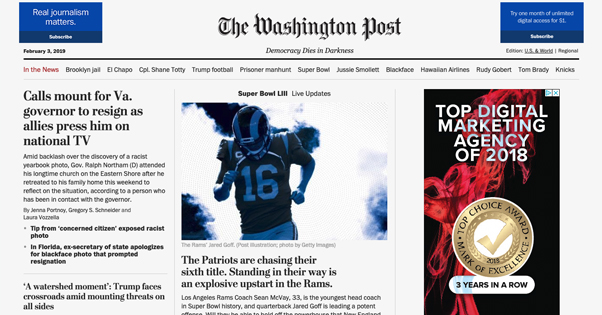


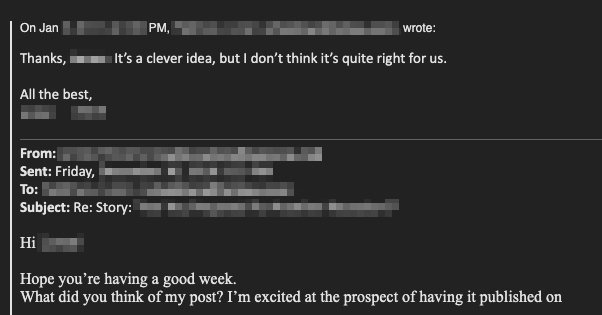
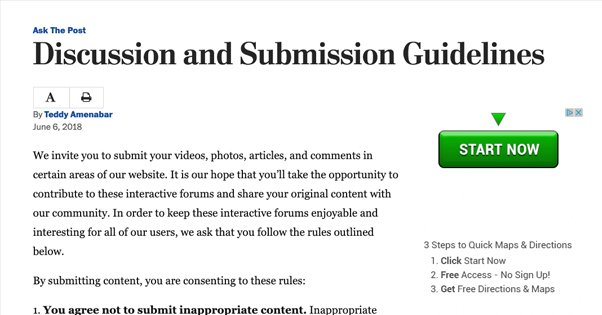

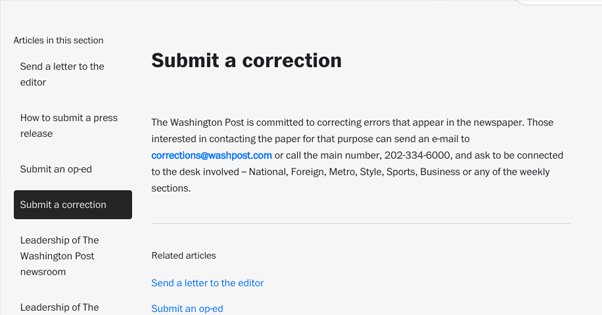



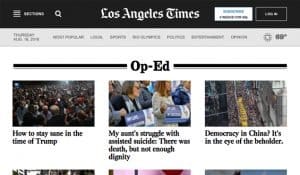

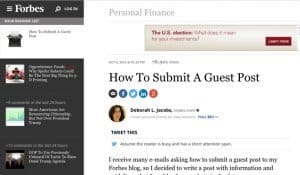
Betty Schwimmer
says:Thank you! Submission guidelines to Perspective and Inspirations? How to find out who is in charge of each section? Thanks.